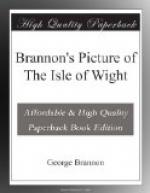East Cowes Castle was built by, and continued for many years to be the favorite residence of the late John Nash, esq., and was with him a sort of architectural pet, receiving from time to time such additions and alterations as appeared to be improvements to the general design, or called for on the score of enlarged accommodation; a circumstance certainly not calculated to insure the greatest amount of domestic convenience (as regards the size and arrangement of the rooms), though no doubt contributing largely to the picturesque effect of the exterior. On Mr. Nash’s demise it was purchased by Earl Shannon,—and after his death by N. Barwell, esq., who in 1846 sold off all the furniture, and valuable productions of art which adorned this beautiful object of interest to visitors.
* * * * *
“EAST COWES PARK”
Is the title of a very extensive building speculation, which comprehends above 100 acres of land, lying between Osborne and East Cowes. This tract was a few years back laid out for the erection of a number of elegant villa-residences, each to be surrounded with its garden and shrubbery, yet to command a delightful marine view. Excellent roads were made, having on either side a foot-path, flower-border, and neat iron pallisade; handsome gateways erected; and a pier, botanic garden, and other attractive improvements commenced or projected. The speculation did not however meet the success it merited, and comparatively few houses have as yet been built.
* * * * *
THE HARBOUR,
To which Cowes is principally indebted for its origin and present importance, enjoys a high character for safety as well as convenience: it is used by vessels of heavy tonnage, either in waiting for a favorable wind, or for the purpose of repairing damages sustained at sea; and after stormy weather, is often crowded with ships of various nations, in addition to those registered at the place—this being the port for the whole island.
There are spacious dockyards, patent slips, &c., both at East and West Cowes: at the latter, excellent dry docks. The naval builders have long held a high reputation for skill: several men-of-war were built here during the last century; and of late years numerous beautiful pleasure-yachts, merchantmen, sloops of war, and other vessels—including the Medina, a first-rate steam-ship (lost on the West India passage), and some large steamers for various foreign governments.
* * * * *
THE ROYAL-YACHT-SQUADRON
Make Cowes their port of rendezvous: they contribute largely to the maritime gaiety of the place, and give particular classes of tradesmen an extensive share of employment; but the town altogether does not, it is said, derive that degree of fostering patronage from their presence which might be expected. The Royal Thames Yacht-club often make this their summer-station.
THE REGATTA




